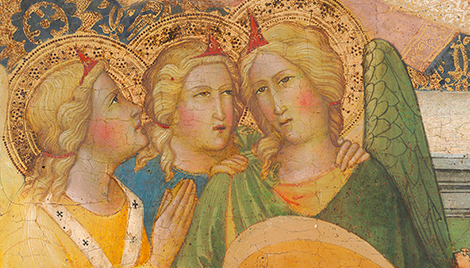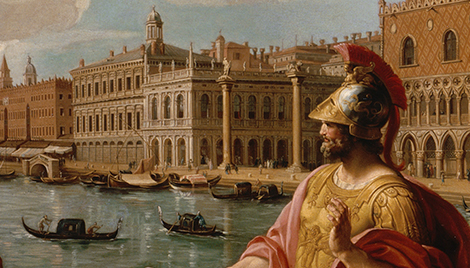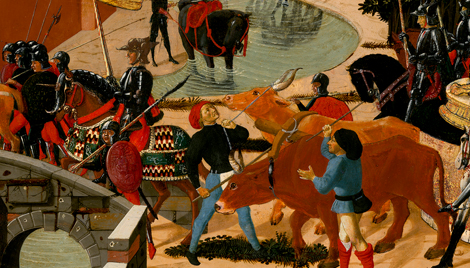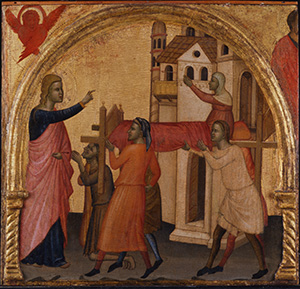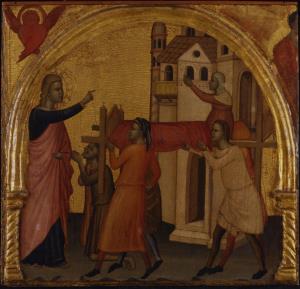The Resurrection of Drusiana
The Resurrection of Drusiana
- Artist
- Francescuccio Ghissi
- Artist Dates
- active 1359-1374
- Artist Nationality
- Italian
- Title
- The Resurrection of Drusiana
- Date
- c. 1370
- Medium
- tempera on panel
- Dimensions
- 34.3 x 36.8 cm (13-1/2 x 14-1/2 in)
- K Number
- K205A
- Repository
- Portland Art Museum
- Accession Number
- 61.32
- Notes
-
Panel was originally part of an altarpiece along with K205B, K205C, and K205D
Provenance
Baron Alberto Fassini, Rome. [1] (Count Alessandro Contini Bonacossi [1878-1955] Rome- Florence); sold to Samuel H. Kress [1863-1955] on 4 March 1932 as Allegretto Nuzi; gift to the National Gallery of Art in 1939; deaccessioned in 1952 and returned to the Samuel H. Kress Foundation; gift to the Portland Art Museum in 1961, no. 61.32. [1] Three related panels at the Metropolitan Museum of Art include Eugenio Ventura, Florence, in the provenance after Fassini.
Catalogue Entry
Francescuccio Ghissi
The Resurrection of Drusiana
K205A
Portland, Ore., Portland Art Museum (61.32), since 1952.(1) Wood. 13 1/2 x 14 1/2 in. (34.3 x 36.8 cm.). Good condition. The scene in this panel follows a story from the life of St. John the Evangelist as told by Jacobus de Voragine in The Golden Legend. In the first scene St. John raises his devoted friend Drusiana from the dead. This panel, along with three others in the Kress Collection (K205B, C, D) were originally associated with three in the collection of Mrs. Murray Crane, New York.(2) An eighth, now lost, would have completed the series. A satisfactory reconstruction of the altarpiece from which the panels come shows K205A and K205B, both of which are arched, above K205C and K205D on the left side of the altarpiece, while on the right, along with one empty space, are the three panels belonging to Mrs. Crane (two of which are arched), and in the middle is a tall panel of the Crucifixion, now in the Art Institute, Chicago.(3) Figures of saints and cherubim in the spandrels of the arched panels were divided into halves by the dismemberment of the altarpiece and so when fitted together again serve to indicate the sequence of the panels. The date is probably about 1370. The figure types in the Evangelist scenes are closely similar to those in Nuzi's Macerata triptych, dated 1369. Provenance: Baron Fassini, Rome. Contini Bonacossi, Florence. Kress acquisition, 1932 –exhibited: 'Italian Paintings Lent by Mr. Samuel H. Kress,' Oct.1932, Atlanta, Ga., through June 1935, Charlotte, N.C., pp. 28 f. of catalogue, as Nuzi; National Gallery of Art, Washington, D.C. (201-204), 1941-52.(4)
References
(1) Catalogue by W. E. Suida, 1952, pp. 20 f., as Nuzi. (2) First noted by L. Venturi (Italian Paintings in America, vol. I, 1933, no. 3). In ms. opinions, G. Fiocco, R. Longhi, R. van Marle, W. E. Suida, and A. Venturi attribute K205A-D to Nuzi, while F. M. Perkins gives them to Nuzi and assistant, and B. Berenson (Pitture italiane del rinascimento, 1936, p. 344) lists them as by Nuzi in great part. (3) The reconstruction is made by F. Zeri (in Bollettino d'Arte, vol. XXXIV, 1949, pp. 21 ff., fig. 5). (4) Preliminary Catalogue, 1941, pp. 144 ff., as Nuzi.

